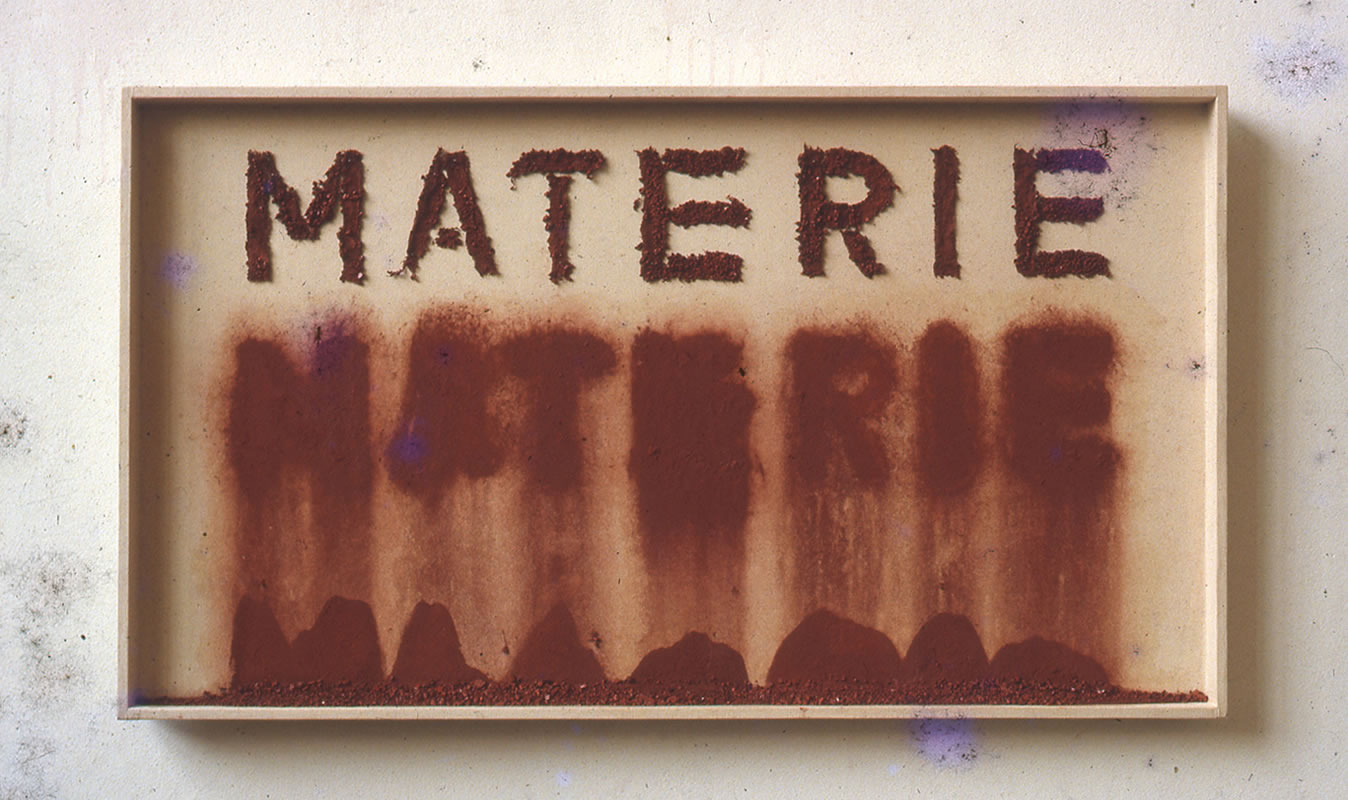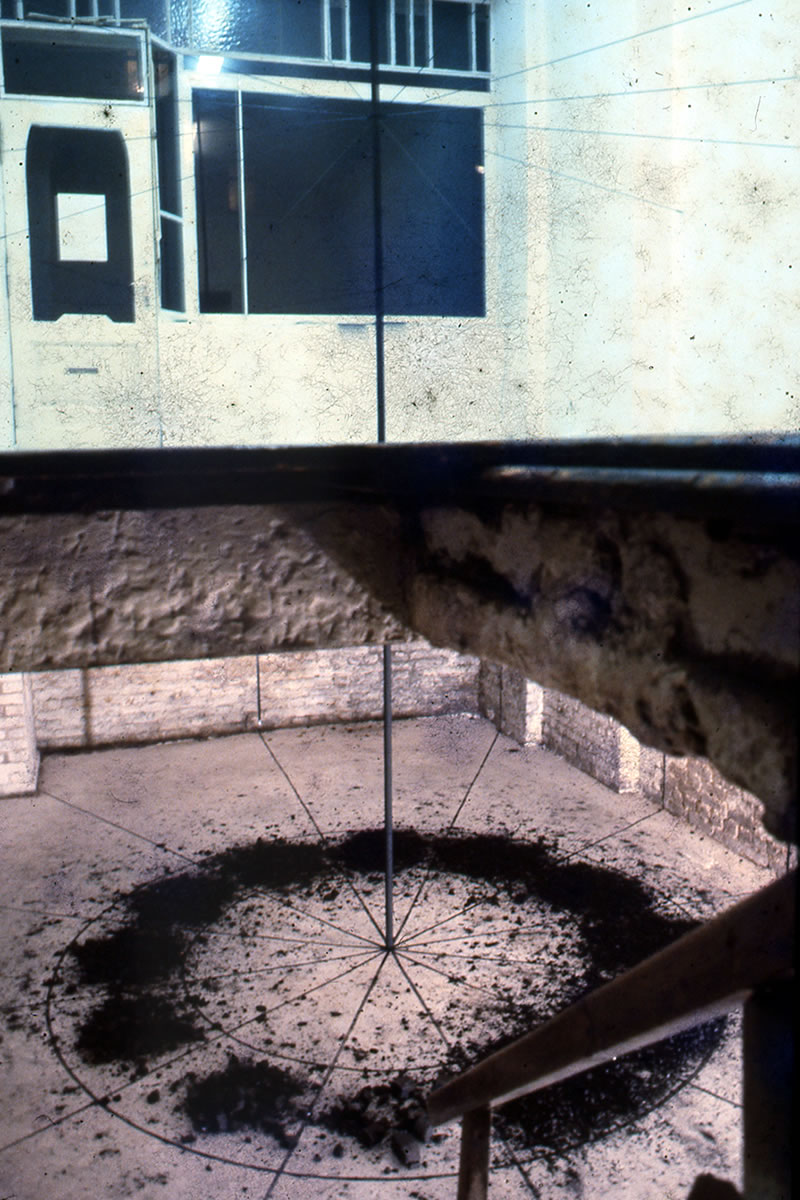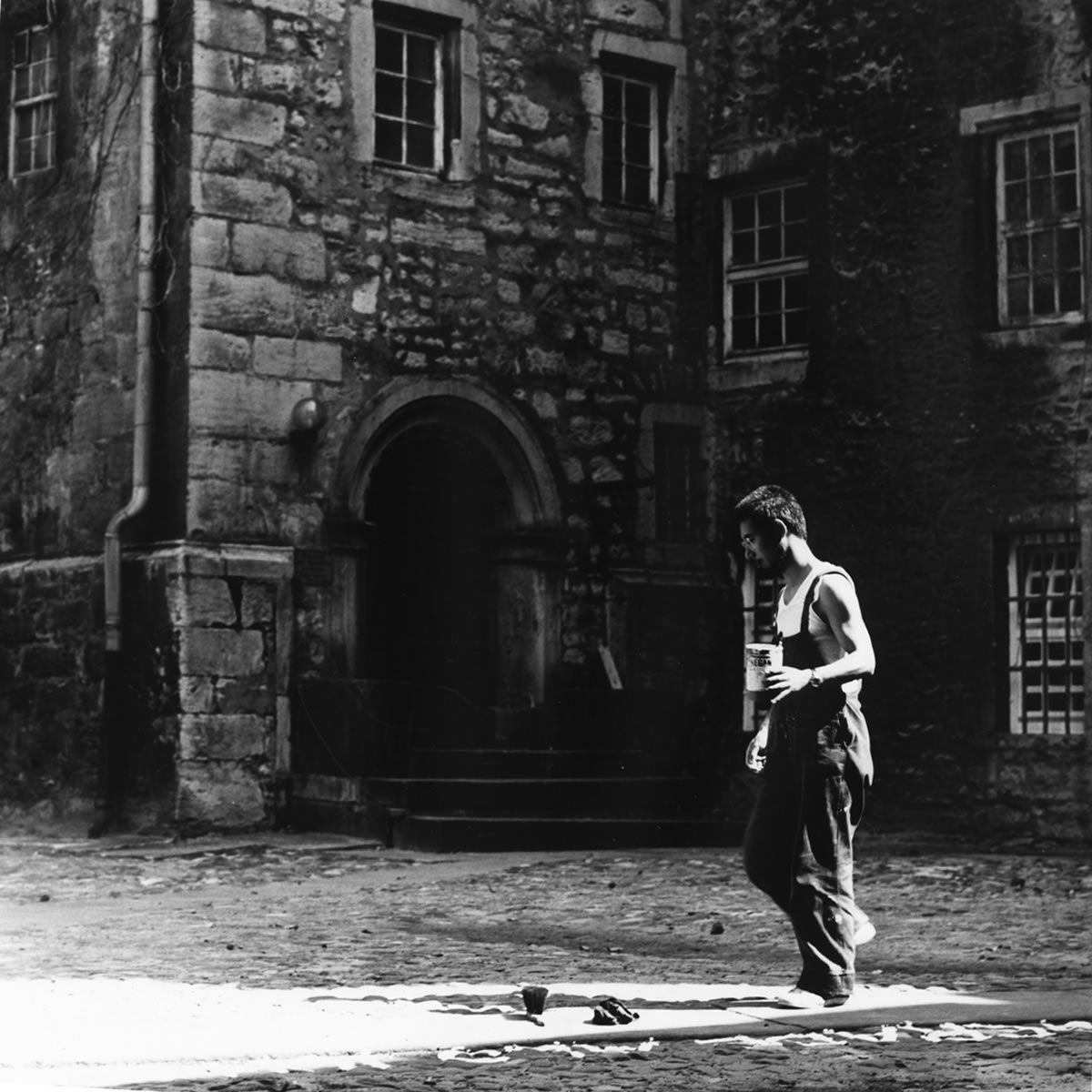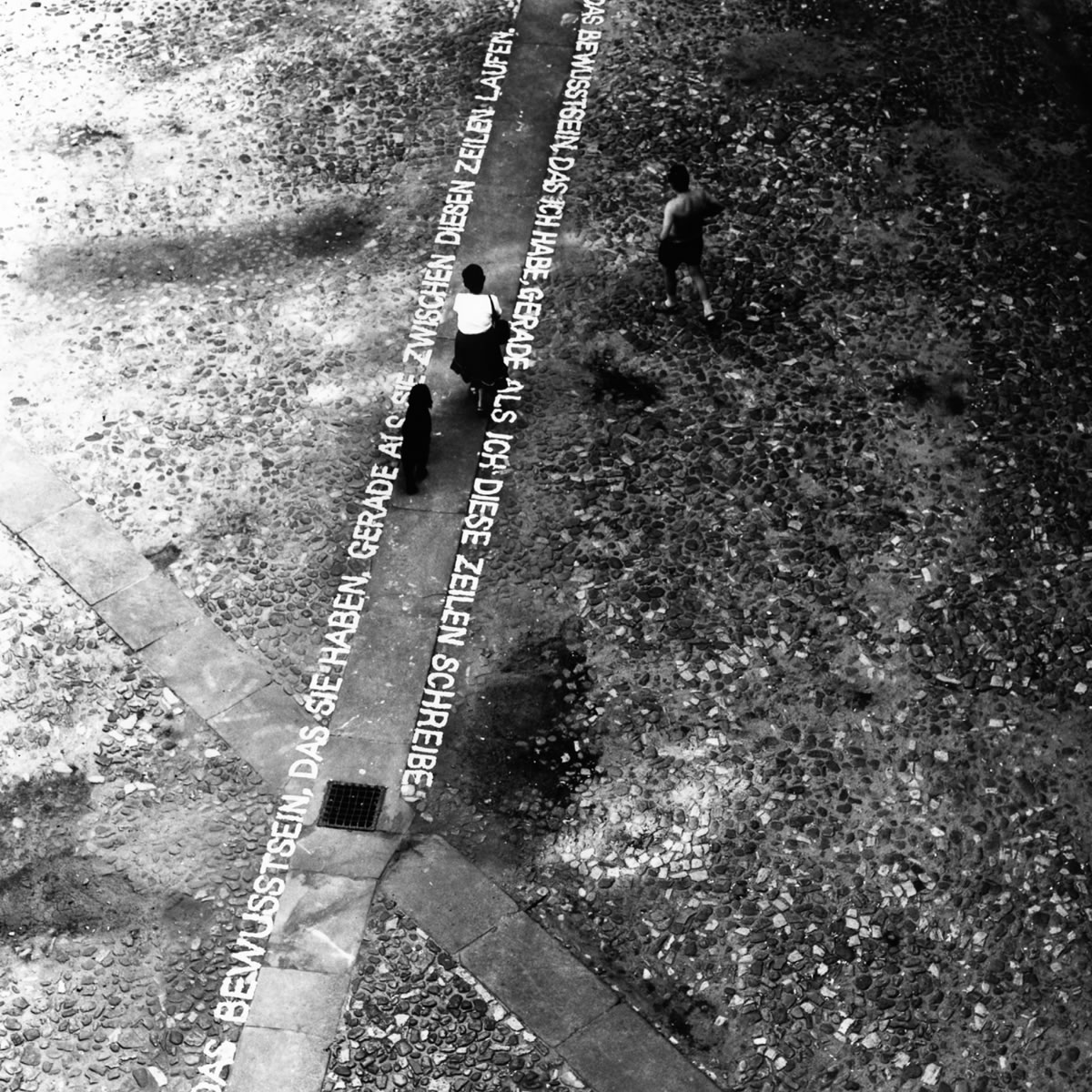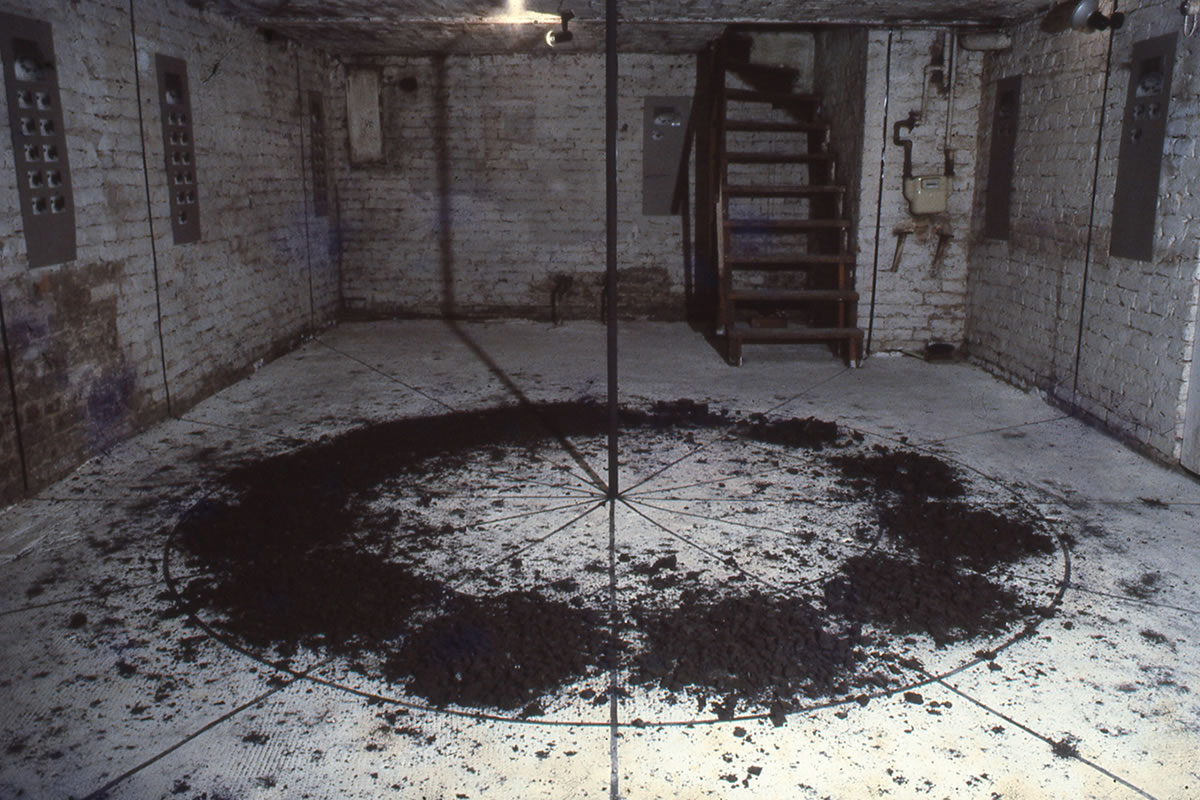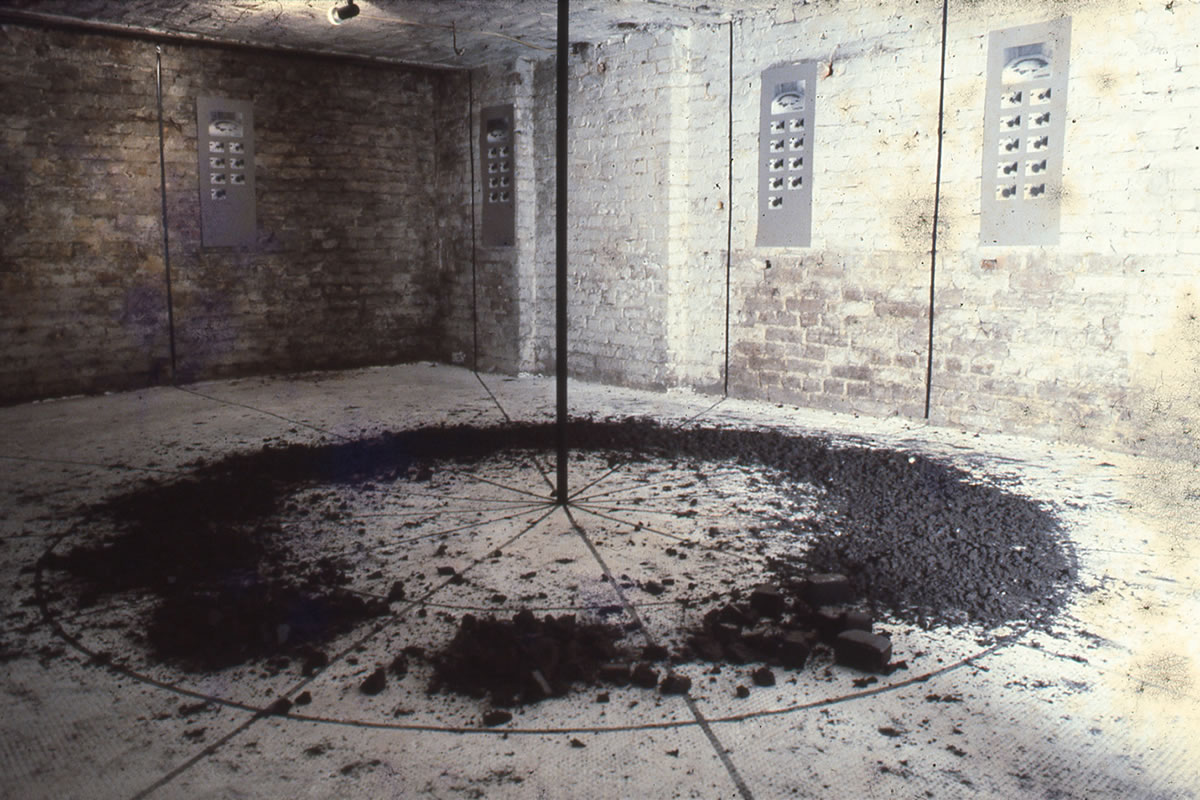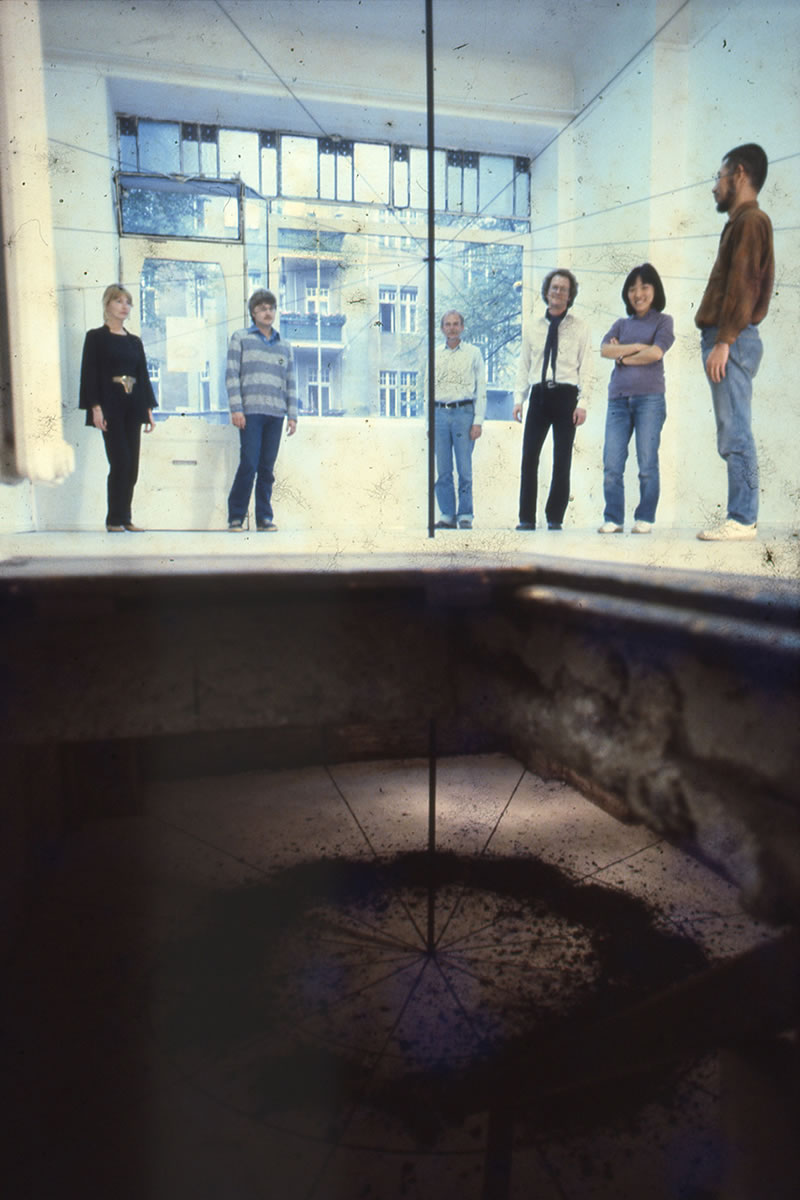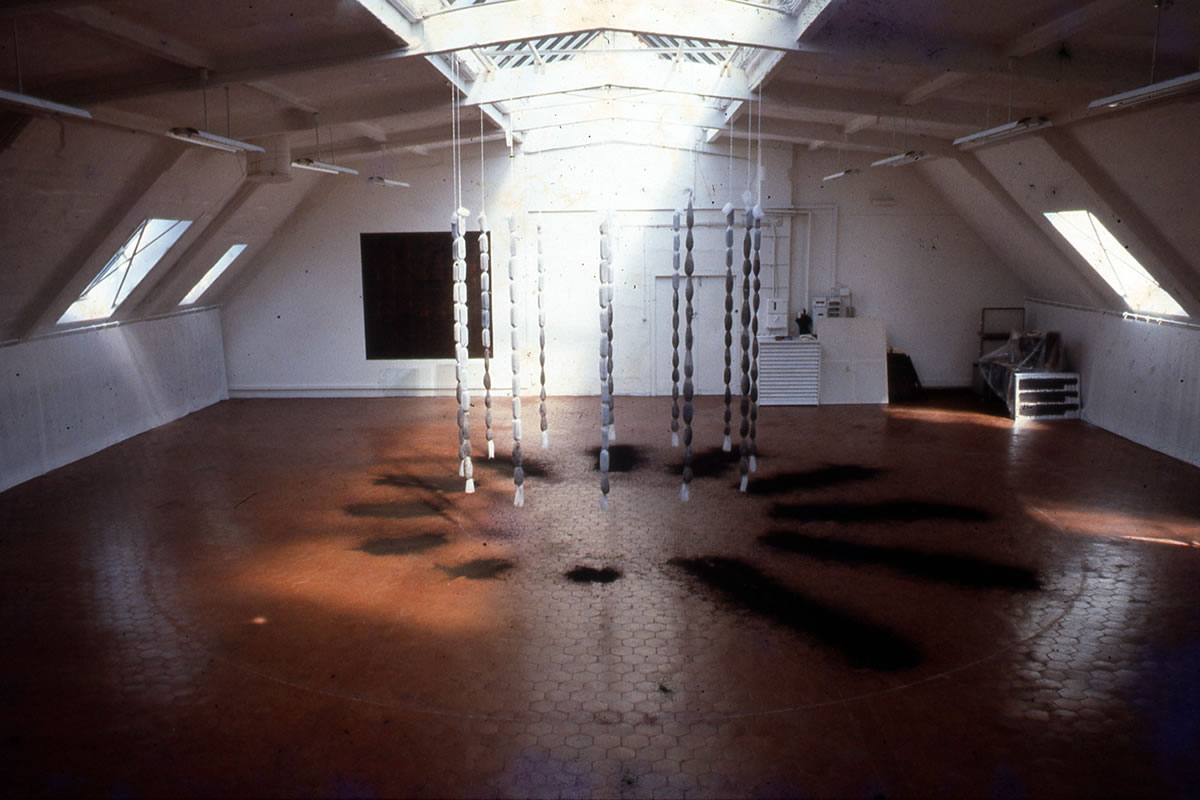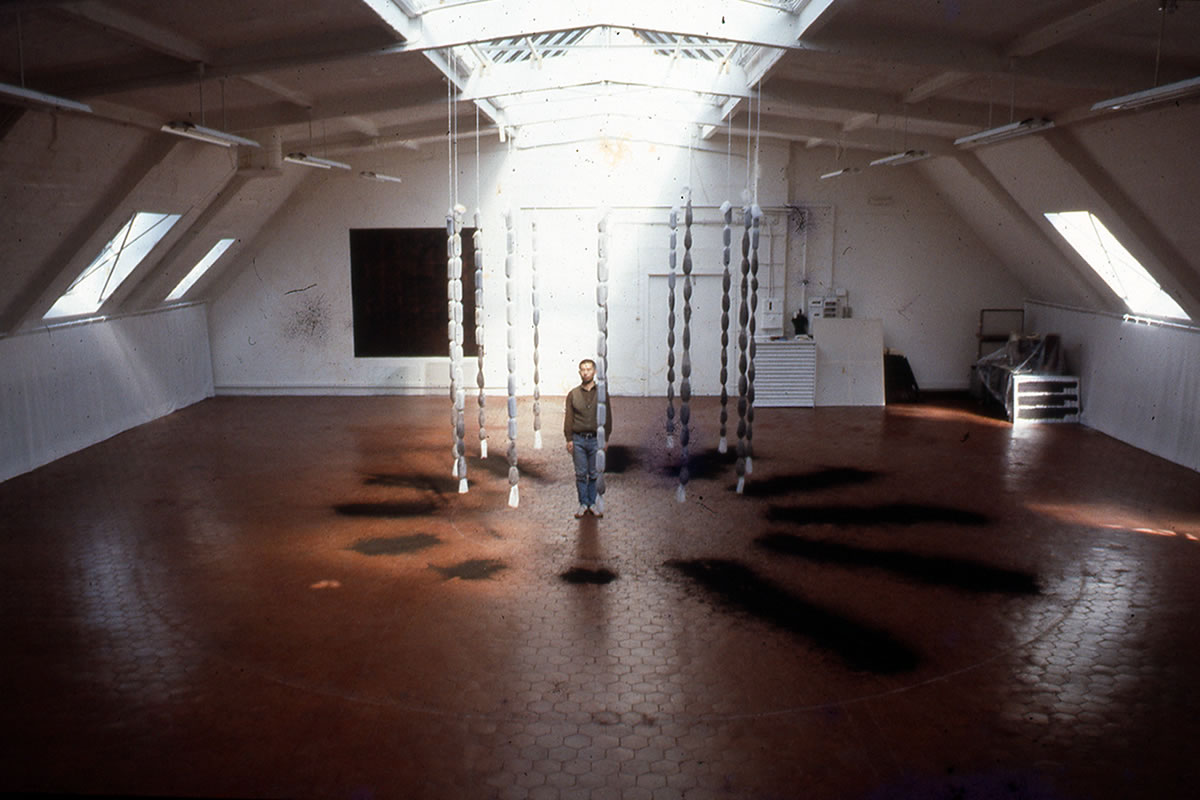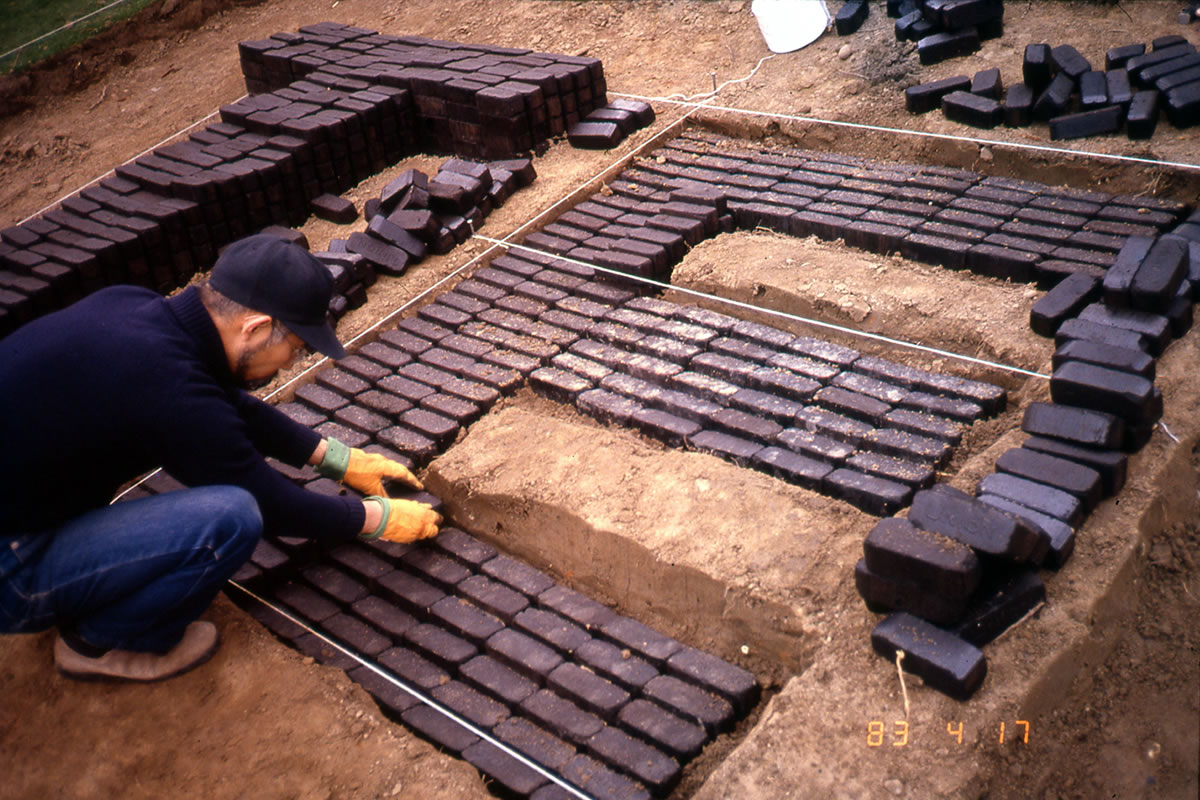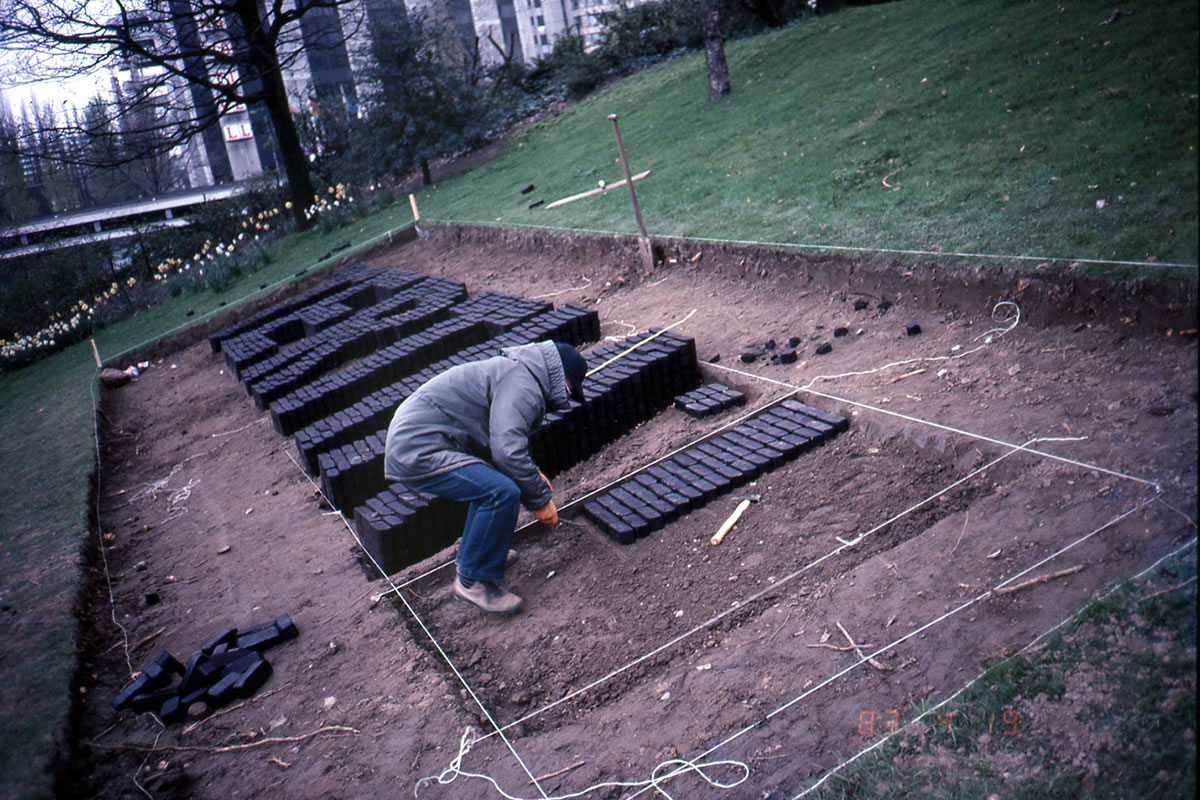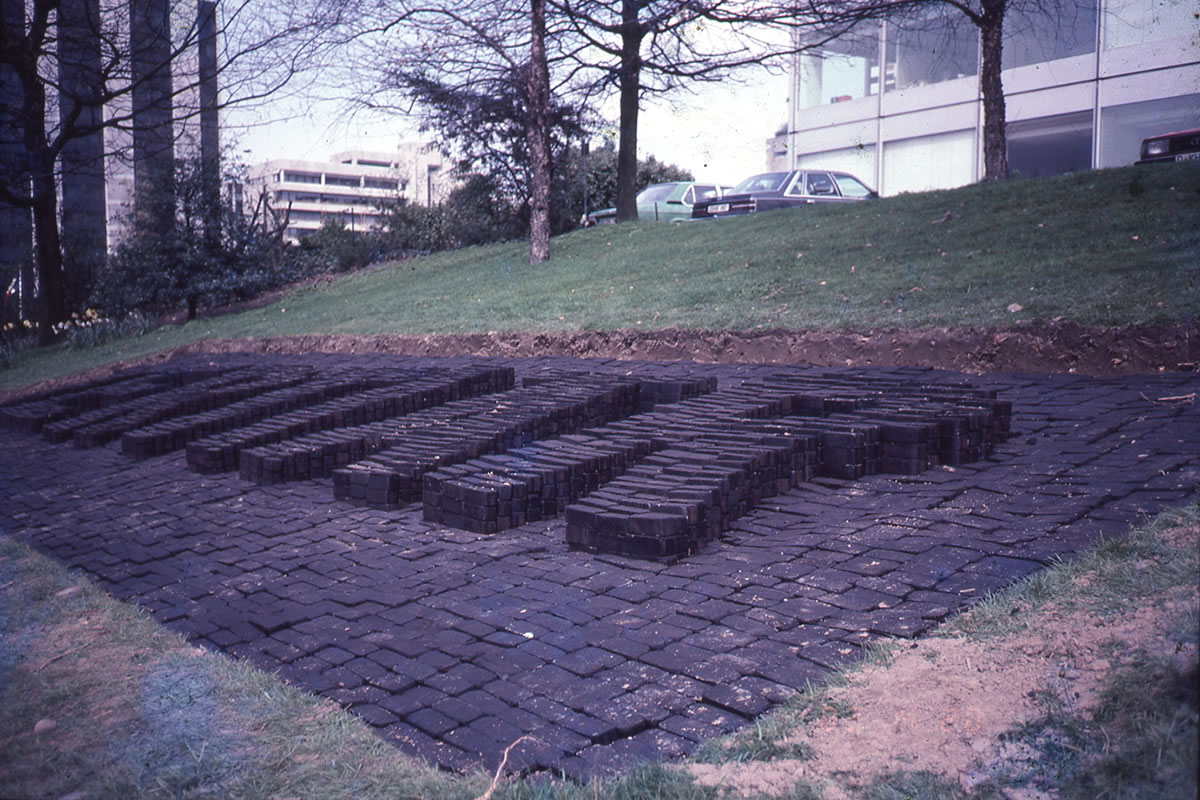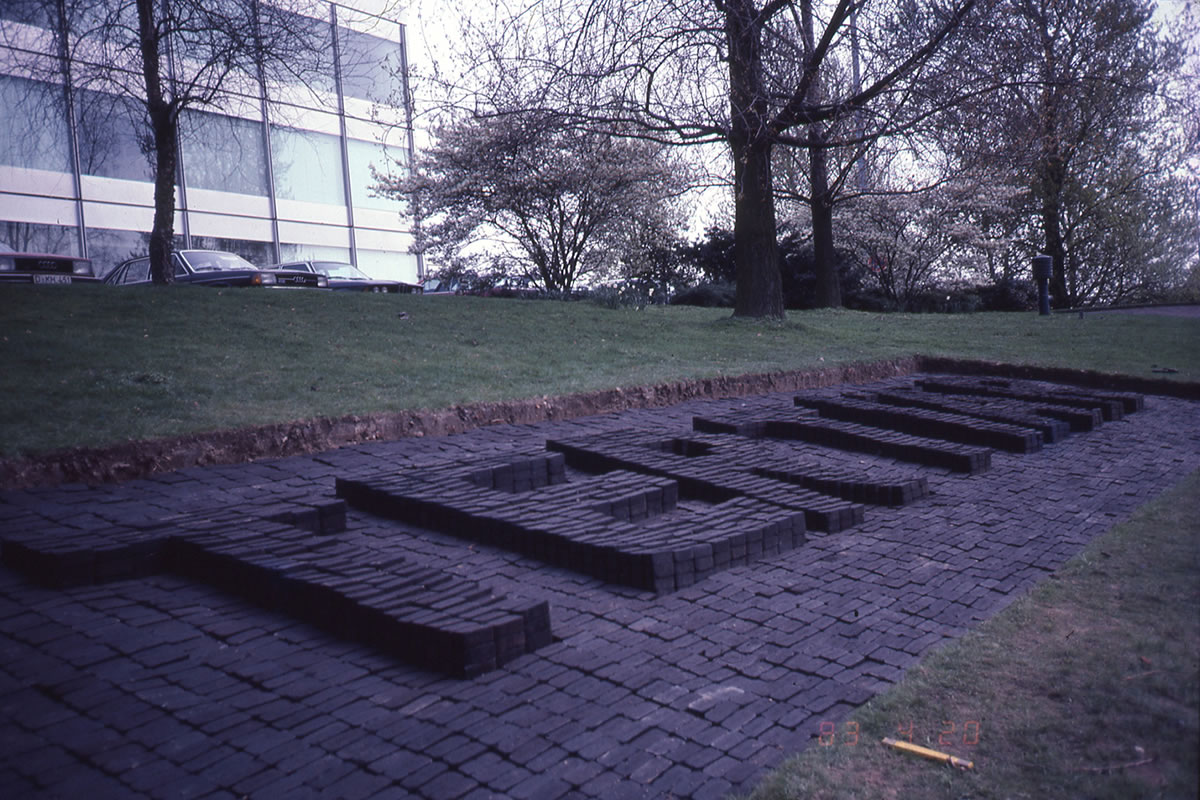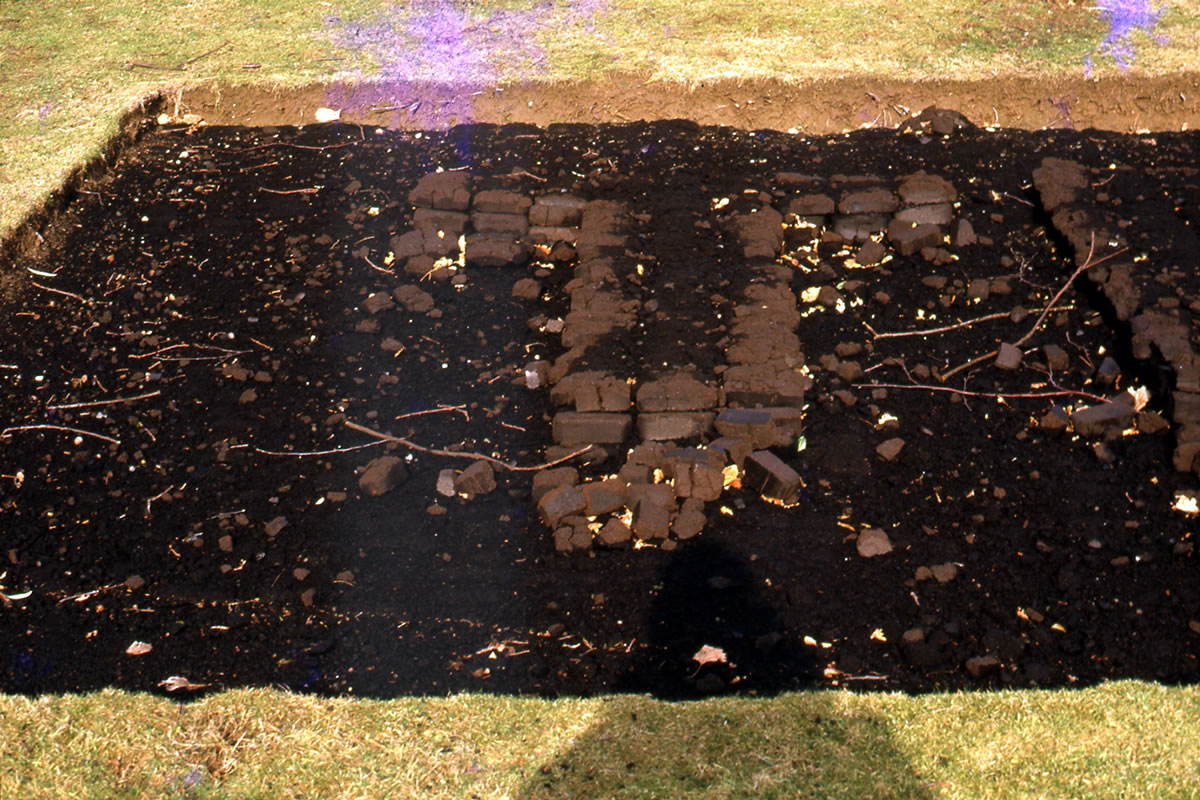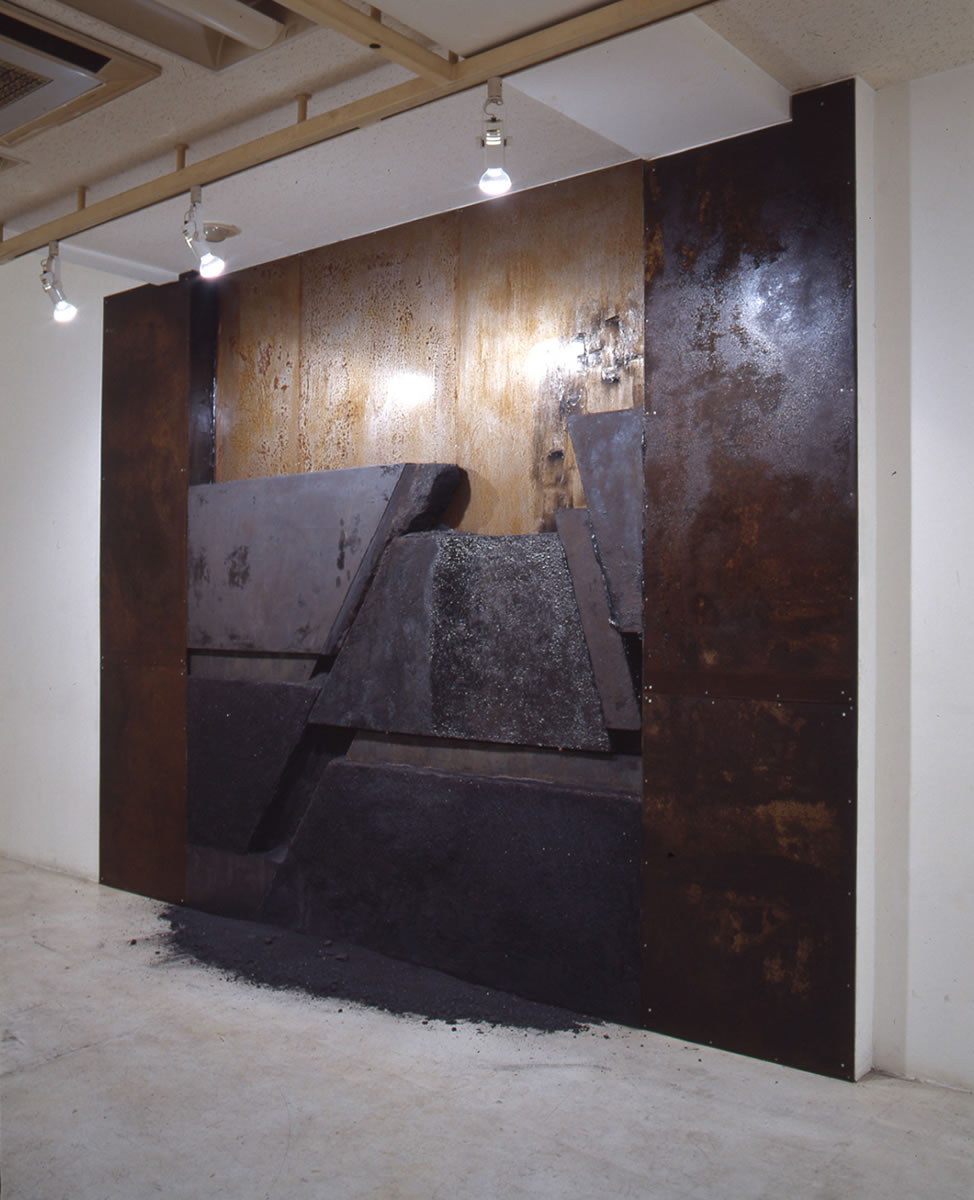Zeit Und Materie
作品と空間の物質性
和田浩一
宮城県美術館 学芸部長
小野皓一の展覧会を宮城県美術館で担当・組織してから20年近く経つが、同展の図録の年譜に掲載した過去の展示写真の中の一枚は、その後も時々思い出すほど印象深いものだった。
それは、作者がベルリン滞在中の1981年に、同地のガレリー・ジアノッツォで開催した個展の写真である。
写真から分かるように、この個展は、画廊の中央に床から天井まで届く棒を設置し、その棒から周囲の壁に空間を12等分する紐が渡されているのだが、その棒があたかも床を貫いたかのように、地下の同じ位置にも同様に棒が設置されて、上階と同じく空間を12等分する線が壁に向かって引かれ、12の区画ごとにブリケット(2)を1分間から12分間砕いた結果を提示する、というものだった。12等分とは、明らかに時の経過を意味するだろう。
太古からの長い時の中で、物質(亜炭)が地中深く生成されてゆく長大なサイクルと、そのエネルギーを再び今日の世界に解き放つことが、ここでは示されていると解することができる。
ブリケットの荒々しい崩壊過程をそのまま提示することで、作者が今日までテーマとすることになる「物質と時間」を表現しようとした注目すべき展覧会だったと思う。
ところで、この展示写真は、上下の階の展示状況をワンショットでおさめるため、地階へ下りる階段の途中から撮影されている。
そのため、地上階の床の断面が目の前の位置に来ており、側面が化粧板などで隠されていないそれは、ごつごつした床の材質をそのまま露わに見せているのである。
この床の断面の物質性と、地下に展示したブリケットの物質性とでは、性質が異なる。砕かれたブリケットは、作品として表現されたものであって、作者である小野がこの個展のために新たに生じさせたものである。
だが、床の断面の荒々しい表情は、私たちの周囲の空間を構成している所与のものが、普段は顕在化されてはいないながら、自らの性質として本来持っていたものであり、それが写真にとられることで、たまたまクローズアップされて露わになり、大きな存在感を放っているのである。
この部分から、床が頑丈に作られていることが分かり、そして地下の煉瓦作りの壁を見れば、展示空間全体がしっかりとした物質で作られていることも了解される。
つまりこの写真は、展覧会の展示状況だけでなく、作品を成立させる展示空間の物質性も同時に見せているのである。
このときの小野のように、物質性をそのまま提示するという作品の場合はなおさらだろうが、作品の表現が本当の意味で有効なものとなるかどうかは、周囲の空間の物質性もしっかりと感じ取れることが重要だと思う。
このことは近年、私自身、強く感じていることでもある。
たとえば、作品を展示するのに適した空間として、ホワイトキューブがしばしば話題になるが、そのホワイトキューブ自体を作っている材質にまで言及されることはほとんどない。
だが、たとえば立体作品であれば、作品が置かれているフロアと同じ素材の上に、観者である私たちも「いる」ということは、鑑賞にとっては重要なことである。
そして絵画なら、床に負けない程度の密度を持った素材で壁が作られ、床の「延長」として壁が「立ち上がって」いると感じられることが重要だろう。
空間の質とは、厳密な意味でそのとき初めて確定され、作品がそこに「位置する」意味が生まれ、表現が際立ってくるのではないか。
上で述べてきた写真は、私に、「作品」が成立することと作品が展示される「空間」の持つ物質的な稠密感との関係を、その後、より深く考えるきっかけを与えてくれた。
日本から留学した小野にとっても、周囲の空間の持つ物質性が、作品や展示にとって重要な課題だったと語ってくれたことを思い出す。
物質の抵抗感や稠密感をまざまざと伝えてくるこの写真は、小野がその後、自らの芸術の拠り所とするものを、期せずして露わにしているような気がしてならないのである。
武蔵野美術大学美術館図書館2015年発行の図録 「KOICHI ONO A RETROSPECTIVE」から抜粋転載。
Materiality in the Art of Koichi Ono | Koichi Wada
Material Property of Artwork and Exhibition Space
It has been almost 20 years since I was in charge of organizing Koichi Ono’s exhibition (1) at the Miyagi Museum of Art.
One of the photos from past exhibitions in the catalogue’s biography made such an impression on me that after all this time I still occasionally recall it.
It was a photo of Ono’s solo exhibition at Galerie Giannozzo in 1981, during the artist’s time in Berlin (fig. 1).
As you can see in the photo, there is a pole installed in the middle of the gallery from the floor to the ceiling.
Twelve strings extend from the pole to the gallery walls, splitting the gallery into twelve equal sections.
However, it looks as if the pole pierces through the floor, to a pole installed in the same spot in the basement below, with the same twelve equal parts created by lines running to and up the walls.
In each segment on the lower floor, you see the remains of pulverized briquettes (2). Each briquette is pulverized for a length of time, increasing in one minute intervals from one to twelve minutes.
These segments clearly signify the passing of time. The material substance of the briquette (lignite) was created deep underground by a gradual cycle of transformation starting in prehistoric times.
In this exhibition, we see that the energy stored by the cycle is liberated once again into today’s world.
I think this exhibition shows what will ultimately become Ono’s theme ‘Material and Time’ through the direct display of the violent process of the briquettes’ destruction.
Incidentally, this photo was taken from partway down the stairs between the two floors of the exhibition, in order to present both floors in one shot.
Because of this, the cross-section of the floor on the upper level is positioned right in front of our eyes. The cross-section, not being hidden by flooring panels, appears as is, its scraggy surface exposed.
There is a juxtaposition between the natures of the material properties of the floor, and those of the briquettes being displayed below.
The shattered briquettes are displayed as a work of art, created by Koichi Ono specifically for his solo exhibition, but the rough expression of the floor is originally a given part of the composition in the surrounding space.
Thus, an object that is not usually seen, with its intrinsic material properties, happened to be photographed close-up, and consequently has a huge presence.
From this cross-section, we can understand that the floor is of sturdy build.
If we look down at the brick walls of the basement, we can see that the entire exhibition space was built with very secure, strong materials.
In other words, this photo not only documents the work in the exhibition, but also shows the material properties of the exhibition space which bring the artwork to life.
The materiality of the surrounding space is what validates a work of art’s expression.
This feature is made even more apparent by exhibiting material properties in their natural state, as Ono has done here.
I have recently been pondering this idea of materiality.
For example, the white cube is brought up again and again in the discussions about suitable spaces for exhibiting art, but the materials with which the white cube itself is made are hardly ever mentioned.
Yet, if you were to display three-dimensional works, the fact of us viewers being ‘present’ on the floor’s same material as the sculptures becomes significant to our appreciation of the art.
As for paintings, it is important to get the sense that the walls ‘rise up’ as an ‘extension’ of the floor, being made of material not inferior to the density of the floor.
The quality of the space, in a strict sense, is determined by its material properties, giving meaning to the ‘placement’ of the artwork in that space and ultimately augmenting artistic expression.
Seeing the previously mentioned photo inspired me to think more deeply about the relation between ‘art’ coming into existence and the physical properties and density of the ‘space’ where it is displayed.
I remember the time when Ono, who left Japan to study abroad, spoke of the importance of the material properties inherent in the surrounding space when exhibiting works.
I reckon that this photo, which clearly conveys the resistance and density of materials, by chance exposes what Ono would later make the foundation of his art.
Passage extracted from the catalogue KOICHI ONO: A RETROSPECTIVE, published by Musashino Art University Museum & Library 2015
1979年 意識についての研究パフォーマンス
Eine Aktion zur Untersuchung des Bewuβtseins 1979
1981年 ガレリー・ジアノッツォ個展
Zeit und Materie Installation in Galerie Giannozzo, West Berlin 1981
1982年 ガレリー・ヴェヴェルカ個展
Zeit und Materie Installation in Galerie Wewerka West Berlin 1982
1982年 時間・物質
Zeit, Time / Materie, Material
1983年 テルツィエール(第三紀)「自然 象徴 空間」ゼーシュテルン野外超克公園 デュセルドルフ ドイツ
TERTIÄR at "Natur Zeichen Raum" Skulpturenpark Seestern Düsseldorf 1983
1993年 プレート・テクトニクス(インスタレーション) 東京・秋山画廊
Plate Tectonics Installation in Akiyama Gallery Tokyo 1993

